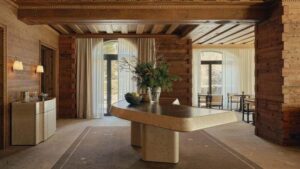Keep the shadows and create more mystery. Sometimes in light painting, less is more. I’ll show examples of creating drama by illuminating less of the subject.
What is light painting?
Light painting is a term that is often used loosely to describe any addition of light to a night photograph. Really, though, light painting is a technique that uses a handheld light source to illuminate a scene during a long exposure. You are quite literally painting the scene with light. Night photographers have used this technique for many decades.

Abandoned airport terminal
The full moon had just begun peeking up from behind the mountains. Still very low in the horizon, I loved the way it was illuminating the abandoned 1920s airport terminal.
What I light painted
I wanted to keep this feel. I walked over to camera left. This was where the moon was shining from. I wanted to mimic the angle of the moon but give the illuminated front of the airport terminal even more definition, so I illuminated the outside using a nice warm white light from a handheld LED flashlight.
I also walked around the interior to illuminate all the rooms. The exposure was a nice, long three-minute long exposure, so I had plenty of time to do this.
What I did not light paint
I did not light paint the side of the building. Sure, this is a large part of the subject. That’s a lot to keep in shadow. But sometimes, it’s okay not to light up everything. Sometimes, it’s good to create contrast and a sense of mystery. And sometimes, it’s also good to be aware of the light around you and to remain consistent with that to make the surroundings look more natural.

Radio telescope under the stars
I wanted to create a lot of drama. Here, there were little light sources, natural or human-made. If I had not lit the radio telescope, it would have been completely black, a silhouette. I didn’t think that was very interesting. But I also wanted to do something other than lighting it up entirely.
What I light painted
I ran to approximately 75 yards (70 meters) away from the radio telescope on the right. I then used a warm white light, using a handheld LED flashlight. Although far away, I didn’t really need much light because the metal object was painted white. I then replicated the same angle on the other side. Yes, that was a lot of running around. Night photography with light painting is rarely ever passive. It’s the most actively creative form of photography I can think of.
What I did not light paint
I didn’t light paint the middle of the radio telescope. That is left in shadow.
Lighting from both sides creates a lot of drama. It’s the reason why many photographers doing portraits of sports athletes choose this method. It looks stark, bold and dramatic.
Illumination and inspiration
Light painters can be inspired by the lighting from many other photographers and painters. Photography is about recording light. How cool is it that in night photography, we have so much control over the light!
Learn more about light painting and night photography!
If you are interested in mastering this genre and much more, and love vintage automobiles dating back to the 1930s, consider the Old Car City USA Night Photography Workshop in October 2023!









